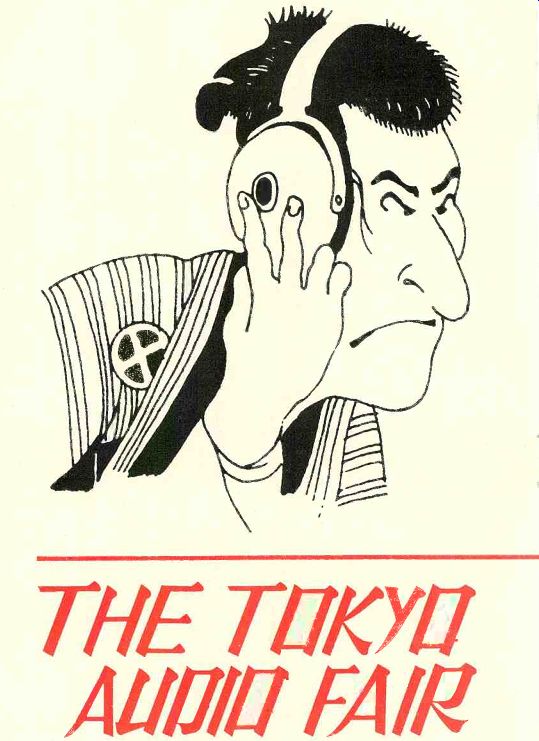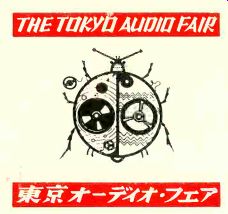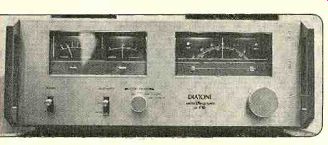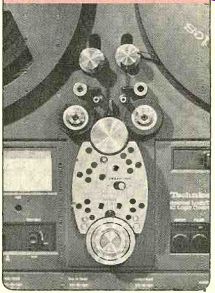A report on breakthroughs, trends, and approaches.
by TECHNICAL EDITOR, LARRY KLEIN

THE 25th International Audio Fair was held in Tokyo late in October last year. I attended the Fair as the guest of Yamaha, who in the previous week had treated me to a whirl wind tour of their widely dispersed manufacturing facilities, music and recreational camps, furniture and audio display rooms, recording studios, five-story music stores, and more. I saw everything from the foundry casting of Yamaha grand-piano frames to the assembly under microscope of their V-FET power transistors, to say nothing of the non-Yamaha temples, shrines, and craft centers I toured.
Judging that I was properly over whelmed, disoriented (it's Wednesday; it must be Hamamatsu), and almost but not quite-recovered from jet lag, my hosts decided it was time to take in the Fair. A projected Sunday visit had to be put off until Monday when an advance check indicated that the premises were wall-to-wall with audiophiles; no one not blessed with X-ray vision or a barbed-wire business suit could hope to see anything but the backs of milling "audio-maniacs," as Japanese sound buffs call themselves.


The Audio Fair took place in two ad joining structures, the main one being a vast geodesic dome. A maze of display booths and rooms was installed on the open floor under the dome, and these had surprisingly effective sound-isolation properties considering the sound levels that were being employed. I was struck immediately by several differences between the usual U.S. hi-fi show and the Tokyo Fair. For one, there was a remarkable amount of live music to be heard in the various display rooms. Yamaha, for example, had built a small auditorium-a "music plaza" in which they presented a constant stream of performers. The shows were being broadcast simultaneously on FM to an "air check" area outside the auditorium, where they were picked up by tuners and fed to fourteen cassette decks. Show-goers who signed up for the privilege were given a blank cassette and could make their own live recordings (on a Yamaha deck, naturally) of the musical proceedings inside. The other major live-music performance (there were a number of minor ones) at the Tokyo show was presented by Fuji Film. A good part of the audience there was also making recordings ( Fuji tape, of course) on a variety of models and brands of cassette decks set up by Fuji.
For the more advanced audiophiles-and Japan seems to be full of them-there were ongoing technical demonstrations. Almost every electronics manufacturer had a test setup designed to demonstrate the virtues of his products by means of graph recorder, meter, and/or oscilloscope. Additional technical information was pro vided by explanatory wall charts liberally illustrated with schematics, block diagrams, waveforms, and graphs. In short, there seemed to be something for everybody-engineer, audiophile, and music lover.
As is true at any large consumer/ dealer audio show, many of the models shown were pre-production prototypes that were not yet available (some of them may never be) in the form in which they were exhibited. And, since the Audio Fair is the place where manufacturers seek to establish or enhance their technical reputations, the emphasis was on high-end, prestigious-one might even say far-out-state-of-the art products.
MANY, if not most, of the major brand names whose advertisements appear in these pages could be spotted at the Fair, but my purpose in putting together this report was not to catalog the exhibits but to discover break throughs, identify trends, and point out interesting approaches to the audio art that haven't yet been widely seen on this side of the Pacific. You may there fore notice the absence of a few famous names whose 1977 product lines have already been discussed (see Ralph Hodges' September report on the Consumer Electronics Show in Chicago). Lacking an all-seeing eye and seven-league boots, and given the crowds and language difficulties, I may have also overlooked the product that is going to revolutionize the entire audio industry in the next twelve months. If so, we will all learn about it together.
Cartridges & Turntables
Despite the heavy competition from U.S. made products, many of which are held in high esteem in Japan, the domestic moving-coil (MC) phono-cartridge industry is apparently going strong. Denon, Fidelity Re search, Satin, Supex, and Onlife all showed their latest models, most of them available with a variety of stylus-tip shapes. It appears that we will be seeing a variety of new cantilever materials such as boron on the market in the next year or so-the industry is still looking for lower mass combined with greater rigidity. Yamaha, among others, will be serving the MC market with built-in "head" amps (otherwise known as pre-preamplifiers) in some of their new preamplifiers and integrated amplifiers. The purpose, of course, is to provide the extra amplification needed by most MC cartridges without having to use external gain modules or transformers.
Judging by the number of them available, tone arms are a significant component on the Japanese audio market. Brands seldom en countered in the U.S. (Grace, Dynavector, Azden, Saec, Lustre, Denon) were on display as well as the more familiar Stax, Micro, and Audio Technica. If there were any significant technical breakthroughs embodied in these arms, they were not reflected in their external appearance. But they were impressive-all of them looked like precision-tooled devices.
As you might suspect from recent ads, the Japanese are putting some effort into minimizing acoustic feedback and internal vibration in their turntables. There has been, for example, a sudden proliferation of turntable bases that incorporate, or are molded from, high-mass inert materials and are supported by very compliant mounting feet. Such bases were everywhere evident at the Fair, usually with beautiful-looking quartz-lock turntables installed. It appeared that every company with a single-play manual turntable in their line also had a quartz-controlled, direct-drive model or two as well. One I saw (JVC's) had a digital operating-speed read out visible in the rim surrounding the turntable platter. I suspect that as far as wow, flutter, rumble, and speed stability are concerned, this new generation of turntables is, as a group, substantially better than the turntable/lathe assembly on which our phonograph discs are originally cut.
Amplifiers
The super-power amplifier, for years strictly a U.S. phenomenon, had by 1976 be come a significant part of the Japanese market. At the Tokyo Fair, virtually every manufacturer showed a power amplifier-or two or three. Most were beautifully styled and adorned with meter readouts and LED deci bel-increment indicators. At least one manufacturer (Optonica) showed a 250-watt-per-channel unit with a direct-reading, liquid-crystal, digital power-output indicator (liquid-crystal technology is responsible for those digital watches with the grey segment ed numbers-as contrasted with the red ones of light-emitting diodes). The unit also had a high-frequency switching-type power supply that should reduce cost, size, and weight. And Sony was showing a prototype Class-D amplifier-the first, to my knowledge, from a Japanese manufacturer.
Amongst the literature I collected was a folder describing a Denon integrated amplifier with a novel phono-crosstalk cancellation circuit. The text is in Japanese, but from what I can decipher from the curves and block diagrams it appears that the circuit can take a stereo signal with perhaps 20 dB of mid-range separation and enhance it to almost 40 dB. This is achieved by employing a combination of phase shift and channel cross-feed.
Several possibly significant trends in amplifier external design were in evidence.
"Cosmetically," as we say in the trade, the styling has gone strongly to long, low slim-line silhouettes. These fiat (physically, that is) preamps, tuners, and integrated amps stack nicely and are available in a choice of black or white-well, not actually white, but a kind of matte silver. There's no question that the pinball-machine look is out; basic black and matte silver are in-and they're beautiful. The long, flat format fitted nicely into installations of the "relay-rack" type at the Fair, but the U.S.-standard 19-inch rack is much too wide for them. Several manufacturers were therefore showing their own mini-racks and cabinets that would accommodate their equipment's 16-inch mounting width. Nakamichi, for one, has a lovely little rack on casters that holds cassette deck, preamp, and power amplifier.
A number of companies, including Lux, were showing vacuum-tube amplifiers whose power-output tubes were unfamiliar-some seemed large enough to-have been borrowed from the transmitters of the local radio station. In addition, there were several solid-state, class-A power amplifiers heating up the area and even a switch on some new integrated amplifiers that would convert the output stages from "normal" to class-A operation.
The power-amplifier chassis of one manufacturer (Diatone) sported four large, black cylindrical objects that turned out to be the housings for pairs of output transistors.
They were hermetically sealed in freon (or some similar gas-liquid) so that the entire assembly became a rather special kind of heat sink. At the moment, it's difficult to tell whether the major advantage of the technique is cooler transistors or hotter advertising copy.
Japan's last generation of amplifiers had distortion figures that in my view were al ready well below the audible level. This year, as a group, they've "improved" their measurable performance even further. Impressive, but it does make me wonder what they are going to do for an encore five years from now.
Finally, I detected what seems to be a trend toward D-C design in power amplifiers (D-C in this case stands for direct-coupled, meaning the elimination of coupling capacitors that could cause phase shift and low-bass loss-and capacitors also usually suffer ...

---------- Many live performances at the Fair permitted audiophiles to
make on-the-spot recordings. At this one, presented by Fuji, a variety of
tape decks were provided, all of them connected to the master mixing console
which can be seen at upper left.

------- Among the sophisticated accessories were these peak/average rack-mounting
meter assemblies. The three units, with different mode settings, are at responding
to the same input One of the quartz-10:1K turntables shown was this JVC model
incorporating a digital speed readout in the rim surrounding the platter.
Pushbuttons provide incremental speed changers.

-------- Among the units with off-beat styling was this tuner with a meter-like
tuning dial. Note Japanese FM dial frequencies.
... from long-term deterioration). The D-C design also relates to direct current, in the sense that a true D-C amplifier will "amplify" the voltage of, say, a flashlight battery connected to its input terminals. This characteristic demands that the amplifier circuits be very stable, since a small unwanted d.c. "offset" voltage in an early stage can result in a large distortion-producing d.c. output voltage at the speaker terminals. Several U.S. companies have had D-C amplifiers for years, but it appears to be big news just now in Japan.
Speakers
From my point of view, the Japanese loudspeaker situation continues to be as confused-and confusing-as it appeared to be during my last visit several years ago.
Major segments of the Japanese audio industry continue to hold the view that speaker sound is a matter of taste and, further, that different nationalities have different tastes-after all, they listen to different kinds of music, don't they? To complicate matters even more, they believe that, as far as national speaker "tastes" go, the U.S. market is divided between listeners who prefer "East-coast" sound and those who prefer "West-coast" sound.
Interestingly, the best-selling speakers in Japan itself have varied over the years from compact systems with clean, uncolored sound to large bookshelf units with strong upper bass and peaked upper mid-range which, oddly enough, parallels rather closely the history of speaker sales in the U.S.
I don't know what it indicated in terms of any design philosophy, but the sound I heard at various speaker displays at the Fair could generally be described as smooth and clean, with a 1-db-per-octave slope centered at 1,000 Hz, falling in the low frequencies and rising in the highs. It's not that the bass was missing; it just seemed to be thin and lacking in "warmth." The highs, however, went way out, cleanly, widely dispersed, and in full measure. Some of the bass lack might have been caused by the acoustic circumstances of the exhibition hall-there were seldom any heavy structural walls nearby to provide bass reinforcement.
For me, however, the Japanese approach to speaker design still remains in the "inscrutable East" category. And, of course, I'm sure that they are equally puzzled by the goings on in the "mysterious West.- For whatever it is worth, however, an engineer in charge of audio matters for the Swedish (!) Broadcasting Corporation recently told me that after extensive technical and listening tests of a large number of samples sub mitted from all over the world, they chose the Yamaha 1000M monitor speakers for their studios.
Quite aside from any question about the "correctness" of the spectral balance they build into their speaker systems, the Japanese seem to be developing a variety of breakthrough technologies for their drivers.
In the past several years we've had Pioneer's tweeters employing a recently developed piezoelectric plastic, as well as Yamaha's beryllium-dome, high-frequency drivers. These innovations are about to be joined by other exotic cone materials, including carbon fiber, boron, and titanium oxide. Pioneer displayed an aluminum-coated beryllium driver, and there were probably more entries I missed hearing about.
There's no question that the Japanese have the technology-and the interest-to pro duce state-of-the-art speaker systems. As I see it, the reason we don't have more fine systems coming from Japan is simply that many manufacturers have decided that "speaker sound is a matter of taste'" and they are not sure whose taste to cater to.
Tape Machines
The few examples of solid-state memory automation I noted were all devoted to locating selections on cassette and elcaset decks. Some units appeared to be completely programmable, while others simply counted blank areas between selections and stopped where required. Optonica, for one, provides different degrees of cleverness in their machines: in order of increasing "smartness" you'll find APLD, APFS, or APSS in various decks. These initials stand, respectively, for "Auto Program Locate Device." "Auto Program Find System," and "Auto Program Search System." The descriptive literature is all in Japanese, but the APLD machine has a row of ten numbered pushbuttons that obviously are used to select the desired programs-possibly by counting "spaces"-and perhaps will play them back in some selected order as well.

------- The novel tape drive on this machine 1:3 driven by a quartz-lock circuit.
The head-assembly switch converts the playback from four-track to two-track.
The APFS and APSS machines each have a single on-off button for the special functions. In addition, two of the machines have a SPACE button which presumably places a set amount of time between dubbed selections by advancing the tape a second or so.
Clarion exhibited a neat little cassette machine--no larger than some conventional decks-that you can load with both a re corded and a blank cassette to turn out duplicates. It was a fairly basic machine (no noise reduction or other extra features), and according to my yen-to-dollar conversion chart it was only about $210: And JVC came up with a bright-bright red, that is-idea. One of their new cassette decks has a "multi-point peak-level indicator" that consists of five LEDs marked -10, -5, 0, +3, and +6. These operate in con junction with the deck's standard VU/dB meters. Since the LEDs are peak-reading and have an extended hold time, all you need do during recording is keep the first three lamps lit most of the time and you've avoided both noise and overload difficulties.
Aiwa's approach to the peak-vs.-average-reading meter problem is to provide both and on one meter face. Each of the two meters has a novel double-needle arrangement, one behind the other. In addition, the ma chine has the most extensive provisions I've yet encountered for optimizing bias level and equalization for use with just about any cassette tape. Not only are there separate three-position bias and equalization switches, but there are also three separate "bias fine adjust" controls. Each of these vernier knobs relates to a particular tape type (LH, FeCr, CrO2) and is set by using a dual-frequency (400 to 8,000 Hz) test signal.
The two test signals are simultaneously re corded on the tape under test and the monitor head provides simultaneous-bin separate-readout for each frequency on the meters. Denon and several other companies also had extensive multiple tape-bias/equalization provisions on their units. Technics showed a handsome matte-black, two-section, rack-mounting cassette unit with trans port and controls in one section, electronics in another. The machine is obviously intend ed to compete in the "professional" end of the cassette market.
Considering all the action in the cassette sphere, there were few new elcaset decks to be seen. Technics displayed a black rack model with a separately mounted fifteen-button "program control unit." And Aiwa showed a handsome, but basic, elcaset unit.
I was told there were also new machines which I didn't get to see-from JVC, Toshiba, and Sanyo. There didn't seem to be too much open-reel equipment at the Fair either. Technics, however, displayed their new top-of-the-line professional-style deck with its new isolated-loop drive system. And Pioneer had a very compact 7-inch-reel deck whose styling might bring a nostalgic tear or two to the eyes of the old timers: it looked, in fact, like a nicely updated Magnecord PT6AH.
Sony presented a continuous demonstration of pulse-code-modulation audio recording on a converted (through a special attachment) video tape recorder. It wasn't clear whether Sony intends to market a commercial product soon or whether this was simply a demonstration of what could be done. I doubt that the setup is intended for the audiophile market-even the most advanced segment of it-but it is certainly a harbinger of tomorrow's home tape machines.
Accessories
It seems that Japanese audiomaniacs love to record off-the-air (despite the problems discussed above). They refer to the practice (in English) as "Air Check," and it is a popular enough activity that high-end cassette manufacturers have difficulty selling machines that can't be automatically turned on ...
----My overall impression of the Fair is that the Japanese are really interested in pushing the state of the audio art as far as it will go. That means that every now and then they are going to seem a little off-the-wall, but most of the time their products are right on tar get. The one area of audio expertise and product know-how that the Japanese have not yet exported to the U.S. in any quantity is program material.
The records I brought home turned out to be incredibly quiet, wide-range, and absolutely warp-free. I'm not sure if the U.S. record manufacturers lack the Japanese production technology or simply their attitude. I don't know how it's described in Japanese, but in English the attitude I refer to is called "giving a damn." -L.K. ----
... by a timer. This, of course, has precipitated a host of really beautiful made-for-recording digital timers. Almost every manufacturer had one-some using a mechanical digital movement, others being totally electronic.
There seemed to be only one digital delay (reverb) system at the show. I didn't get to hear it, and I discovered its existence only when I went through my packet of Optonica literature.
Several manufacturers showed add-on amplifier-output monitoring units employing meters, LEDs, or both. Technics had three of their meter-readout units stacked with their respective mode switches set variously for peak, peak hold, and average. It was fascinating to watch the three meters as they responded differently to the same musical signal.
FM Tuners
It may sound strange, but I didn't get a chance to listen to any FM broadcasts while in Japan, though I saw and heard plenty of FM tuners. By U.S. standards, there are relatively few FM stations even in the major cities. In Tokyo, for example, there are one or two broadcasting very high-quality audio-the NHK chain-as well as several that, according to one engineer, averaged about 200 percent (!) modulation. The only way to reduce the tuner distortion under such circumstances is to provide the option of switching to a very wide bandwidth hence the wide-narrow switch seen on many Japanese tuners. In the U.S., however, such a feature isn't that important since the broadcasters have other practical considerations-such as the FCC monitoring of the crowded FM band-that tend to minimize broadcast overmodulation. Given the general state of Japanese FM broadcasting, the exhibitors preferred to demonstrate their equipment using their own low-power, high fidelity, across-the-room broadcasts.
The lack of widespread FM broadcasts also accounts for the disproportionately high sales of integrated amplifiers and the relatively low sales (compared to the U.S. market) of receivers. However, this has certainly not put any visible damper on Japanese FM-tuner engineering; FM-tuner distortion figures, for example, are being driven ever downward even at the lower-price end of the lines.
Several manufacturers were showing alternatives to the conventional slide-rule tuning dial. Aside from one or two liquid-crystal, digital-readout models, there were FM units (Diatone, for one) that seemed to have two large meter movements-until you noticed that one was actually a rotary dial calibrated in megahertz. There were a few other variations on that same theme, almost as though the manufacturers wished to disguise the fact that the device shown was a tuner.
A few of the tuners (Sanyo/Otto) had deviation meters, possibly to alert the user to the gross overmodulation discussed earlier. As with amplifiers, the tuners are undergoing constant technical improvement. Now, if only the sonic quality of the broadcast material would start to improve at an equal rate ….
Also see:
TECHNICAL TALK: A Good Word for Bureaucracy
Source: Stereo Review (USA magazine)